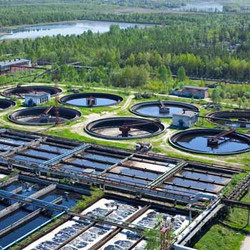Wastewater Treatment
Posted by Pure Aqua, Inc. on Aug 13th 2019
When you hear the word ‘wastewater’ what image springs to mind? For some people it might be a horrific picture filled with large flowing rivers of human excrement and toxic sewage sludge running out of drain pipes and into the ocean. For others it might be vast wastelands of toxic waste spilling out of giant pipes into endless pools of slime and sludge, while a factory belching out black smoke looms in the background. It’s actually not quite as bad a picture as it may seem. While some wastewater does contain urine and feces (what we would probably associate with slime and sludge), other forms do not. Wastewater is actually a term used to describe liquid waste discharged by domestic homes, commercial and industrial properties and agricultural runoff. It is any kind of water that is used to flush away contaminants and certain concentrations. The part that has urine and feces is called sewage, which is a subset of wastewater. This is also the water that is disposed of through sewers and drained into a cesspool emptier. Sewage is also referred to as ‘blackwater’; a very appropriate name for this kind of waste. In fact any water is classified as ‘blackwater’ if sewage has contaminated it in any way.
Other wastewater is often referred to as ‘greywater’. This is usually water that contains bath/shower, sink, floors, washer machine, dishwasher, agricultural, commercial, industrial and other drained water. This water can be treated so that when it is released back into the environment, it is not harmful. This type of treated water is usually used for agricultural and irrigation purposes. This method is called wastewater treatment.
Waste water treatment is the process with which water is treated to be released back into the environment with no harmful side effects. Waste water treatment involves using chemical, biological, and physical processes to remove contaminants from the water. The sought after outcome is to produce environmentally safe liquid or solid waste that can be disposed of or reused in a farm land setting, usually as a fertilizer. MBR which is a membrane bioreactor is a special process that combines an activated sludge treatment with a liquid solid membrane. Membranes separate sludge, ensuring higher quality treated water free from suspended solids. The membranes retain activated sludge at higher concentrations, resulting in more efficient BOD and nitrogen removal. The membrane has a vast number of smaller pores delivering stable and high water permeability with minimal clogging and higher permeated water quality.
Another way to treat waste water is with a UF or ultrafiltration system. UF is a pressure driven membrane separation process that removes suspended or particulate matter from water. The solution is more reliable than a conventional multimedia filter that removes approximately 10 microns or larger, where an ultrafiltration membrane pore size ranges from 0.01 to 0.10 micron. In addition to quality turbidity removal, ultrafiltration membranes efficiently remove bacteria and most viruses.
All in all wastewater is very treatable, despite what many may think. In fact, many cities used reclaimed or recycled water for irrigation and watering of public lawns. Reclaimed water is treated wastewater (grey water) minus the sewage. Some cities are even contemplating treating wastewater for drinking water. Wastewater treatment is advancing very rapidly.
 ENGLISH arrow_drop_down
ENGLISH arrow_drop_down
 ESPAÑOL
ESPAÑOL ???????
??????? PORTUGUÉS
PORTUGUÉS FRANÇAIS
FRANÇAIS

